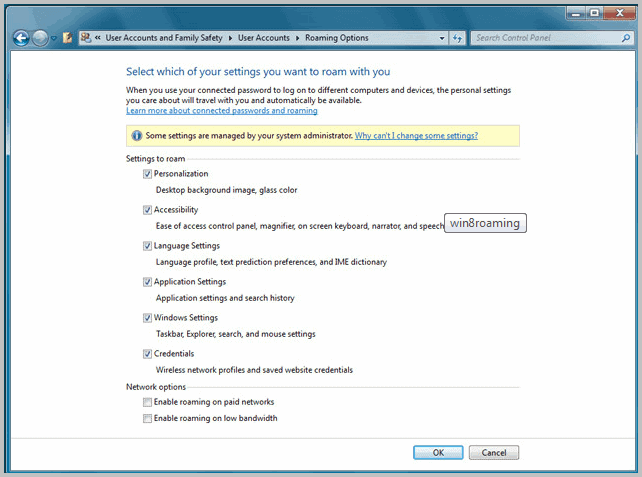Windows 8 To Include User Account Roaming

Would not it be nice if you could just log on to any computer with Windows installed and directly work with your custom settings and preferences? This is apparently becoming reality with the release of Windows 8.
The upcoming Microsoft operating system will feature a roaming option that can be enabled to synchronize preferences and settings with the cloud.
Native data syncing means that users can log on to every computer running Windows 8 to work with their preferences and settings, provided that the roaming feature is not disabled on that computer.
User Account Roaming

The list of personal settings that get synchronized with the cloud are the following:
- Personalization: Desktop background image, Windows colors
- Accessibility: All accessibility related tools and settings, including the magnifier, on screen keyboard and speech recognition settings.
- Language Settings: The language profile, text prediction preferences and dictionary.
- Application Settings: Settings for applications and the search history.
- Windows Settings: Taskbar, Windows Explorer, Search and Mouse settings.
- Credentials: Wireless network profiles and website credentials.
All options are selectable individually, so that only the data that you want to synchronize will be available when you connect a Windows 8 box to the cloud.
This opens up new and interesting options. Previously when you wanted to work with a similar set of settings, you needed to use third party tools to synchronize the settings, or configure the operating systems on each device and computer manually.
With the roaming feature, that is no longer necessary for core settings and preferences. Imagine traveling to Japan and synchronizing a computer in an Internet Cafe with your cloud settings to change the display language from Japanese to your language.
Obviously, you would have to sign in to your Windows account and the machine in question would have to support the feature. You can also make use of it when you purchase a new PC as core settings could be carried over this way.
The Roaming options are accessible via the User Accounts control panel applet. Network options are listed on the same configuration page to enable roaming on paid networks and low bandwidth networks.
Since those options exist, Windows should have options to identify those types of networks. It should not be to difficult to identify low bandwidth networks, as it can be done with a basic speed test. Paid networks on the other hand may be difficulty to identify, and it will be interesting to see how Windows 8 will handle that identification.
This ties in well with the rumor that users can use email addresses and passwords to log on to the system, as those could be used at the same time to provide the login credentials for the cloud synchronization feature.
I personally think that the roaming feature has been long overdue, and that a lot of Windows 8 users will benefit from the feature. Not all users want data of theirs to be stored in the cloud and that is the most likely reason why the feature is not turned on by default.
Closing Words
Roaming profiles don't sync all user data with the cloud but it does sync a lot of it including customization, credentials, and language settings.
Update: The feature is now part of Microsoft Account, a new online account for all things Microsoft.




















“long overdue…”
I’d say so! It was a neat new feature when it came out on ISPF on IBM mainframes — in 1974. That was 37 years ago.
Now Windows finally has this (or will, when version 8 is released).
I should send this to my employer – just for a laugh.
They will be horrified that users might have freedom to personalise their Windows settings.
I bet most organisations’ IT departments will lock this down severely or disable it completely so they can continue their zealous controlling ways.
This sounds great (nothing Apple could do!)
With regards to identifying paid networks, does this mean your wireless networks? Windows 7 (and Vista, I believe) both could recognise exactly if it was a paid network – I think that, when it runs a test to see if the internet is working, it sees that it is connecting to a different network…
Quite similar to MobileMe’s synchronization of Preferences of all apps.
What you want to bet this will require a Windows Live account? Seems like another way to pull people in.
It is an optional feature.
Agreed on that part about letting you configure what’s sharable. That’s something I’m thankful they built in.
Regarding the data not being available offline at all… That seems far fetched – the machine has to cache some of that information (i.e. background image) else it would be unbearably slow.
Microsoft has supported complete roaming profiles for years; this just feels like they are moving it to the cloud and excluding documents. Of course, the old roaming profiles were not designed to work across slow links (i.e. the internet) and included everything.
They are, however, cached on the local machine.
Roaming Profiles: http://en.wikipedia.org/wiki/Roaming_user_profile
While I applaud this, it’s also concerning that credentials will be shared. How do we know that the internet cafe “let go” of our credentials when we left?
I can see this in a corporate environment, but I think people should think long and hard about this and consider the privacy/security issues that come along with it.
Well you can configure what you want to share. And the data is likely linked to the account, maybe not even available offline at all.
If not available offline, then I’m curious to see how it’ll handle my logging onto my netbook on the train, or anywhere else where I may not be connected. I’d imagine they’re not eliminating local profiles, right?